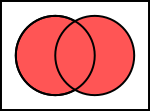Set theory is the branch of mathematical logic that studies sets, which can be informally described as collections of objects. Although objects of any...
42 KB (5,062 words) - 10:30, 25 October 2024
In set theory, the complement of a set A, often denoted by A ∁ {\displaystyle A^{\complement }} (or A′), is the set of elements not in A. When all elements...
12 KB (1,486 words) - 11:29, 14 September 2024
In set theory, Zermelo–Fraenkel set theory, named after mathematicians Ernst Zermelo and Abraham Fraenkel, is an axiomatic system that was proposed in...
46 KB (6,252 words) - 21:13, 11 October 2024
In set theory, the intersection of two sets A {\displaystyle A} and B , {\displaystyle B,} denoted by A ∩ B , {\displaystyle A\cap B,} is the set containing...
12 KB (1,737 words) - 23:16, 26 December 2023
In set theory and its applications throughout mathematics, a class is a collection of sets (or sometimes other mathematical objects) that can be unambiguously...
9 KB (1,275 words) - 14:29, 6 June 2024
In set theory, the union (denoted by ∪) of a collection of sets is the set of all elements in the collection. It is one of the fundamental operations...
10 KB (1,341 words) - 00:09, 23 October 2024
Axiomatic constructive set theory is an approach to mathematical constructivism following the program of axiomatic set theory. The same first-order language...
212 KB (35,138 words) - 19:05, 29 October 2024
Naive set theory is any of several theories of sets used in the discussion of the foundations of mathematics. Unlike axiomatic set theories, which are...
34 KB (4,715 words) - 11:25, 21 September 2024
Musical set theory provides concepts for categorizing musical objects and describing their relationships. Howard Hanson first elaborated many of the concepts...
21 KB (2,620 words) - 11:20, 16 December 2023
In mathematical logic, descriptive set theory (DST) is the study of certain classes of "well-behaved" subsets of the real line and other Polish spaces...
10 KB (1,595 words) - 09:57, 22 September 2024





